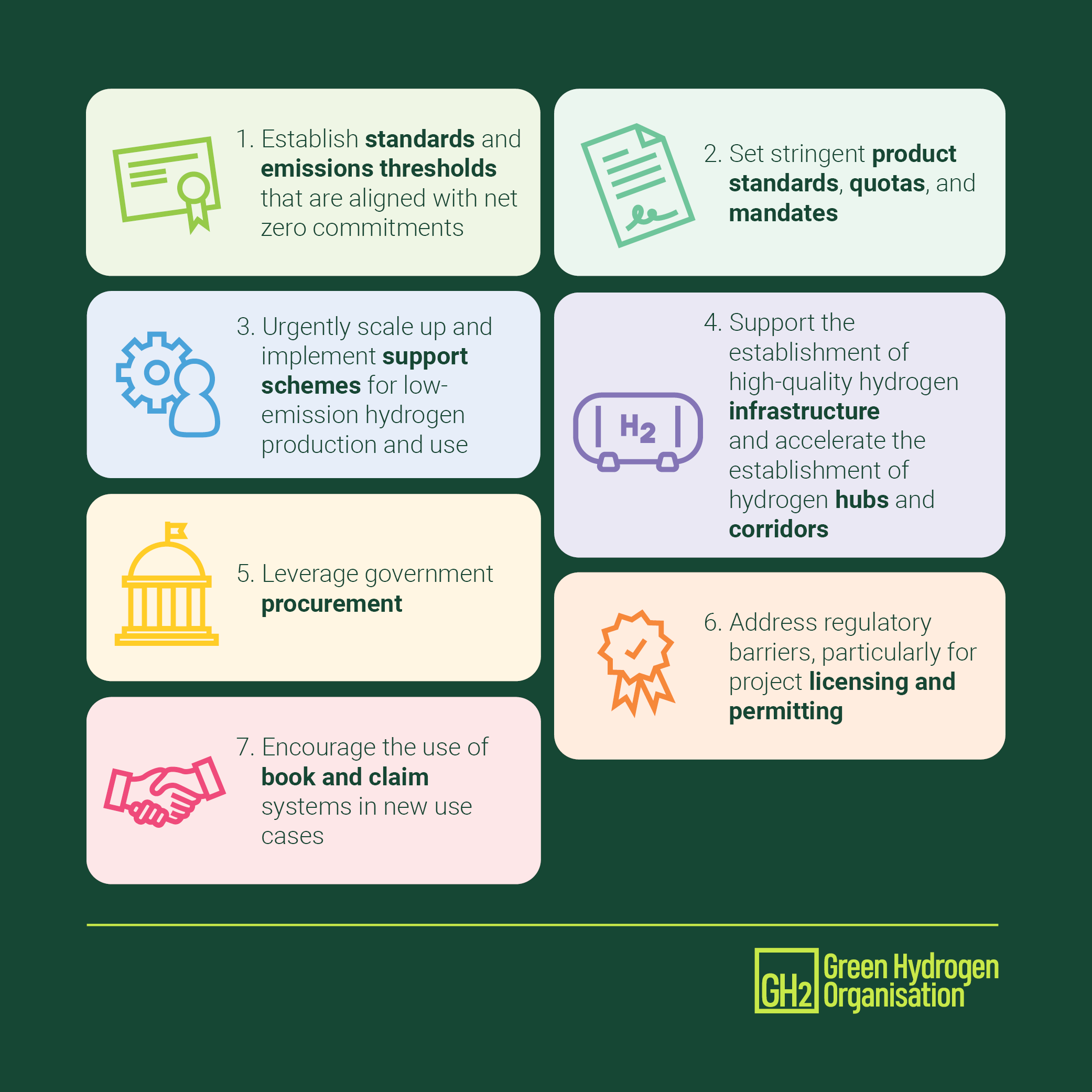Seven Recommendations for Increasing Demand for Green Hydrogen-Based Products

1. Establish standards and emissions thresholds that are aligned with net zero commitments
Governments should set maximum emissions thresholds that are aligned with their net zero commitments and establish policies that favour hydrogen production and use that deliver the greatest emission reductions. While efforts to find a common method to calculate emissions from the production, conditioning and transport of hydrogen are welcome, governments should prioritize the production routes that can achieve verified emission intensities that trend towards near zero by 2030.
2. Set stringent product standards, quotas, and mandates.
Governments can play a crucial role by mandating decarbonised hydrogen use in both existing and new use cases. A leading example is the binding quotas established under the European Union’s Renewable Energy Directive, which include a binding target of 42% of green hydrogen in total hydrogen consumption in industry by 2030, a minimum level of 1% in transport sector, and binding targets in the aviation and maritime sectors. These send a strong signal to producers and consumers alike that a large and growing market will be established within a fixed timeframe. Member states need to implement these demand side measures as soon as possible to support this mandate.
3. Urgently scale up and implement support schemes for green hydrogen production and use.
In the last three years there has been a significant increase in government programmes to support first movers in hydrogen production and use. However, in most cases, these programmes have been have been severely delayed. The Clean Hydrogen Production Tax Credit under the Inflation Reduction Act in the United States, which offers a 10-year incentive for clean hydrogen production of up to $3/kg, was only finalised in the final days of president Biden’s term in this month, and its future is very uncertain under the new Trump administration. Programs to support low-emission hydrogen will not succeed in bringing projects to market if the regulatory framework is unclear and developers struggle to demonstrate regulatory compliance.
Other tax credit schemes are being introduced in Australia and contracts for difference schemes are coming online in Japan and South Korea shortly. The EU Hydrogen Bank’s auction scheme has completed a pilot and Spain, Lithuania and Austria are participating in the second auction which launched in early December with total funding in the new round amounting to around EUR 2 billion. The H2Global instrument is also gaining traction to secure imports of green hydrogen and derivatives into Europe with EUR 3 billion committed by Germany and the Netherlands. However, the scale of these schemes is not sufficient to meet agreed targets, and these programs need to be expanded and extended to other energy markets.
4. Support the establishment of high-quality hydrogen infrastructure and accelerate the establishment of hydrogen hubs and corridors.
The new value chains emerging from the use of hydrogen as an energy vector are complex and require coordination among multiple private and public stakeholders. Governments can play a key role in developing networks of hydrogen producers, consumers, and connective infrastructure to accelerate the use of hydrogen, matching the scale-up of clean hydrogen production and associated infrastructure to regional demand. Pipelines and storage facilities, for example, often have the characteristics of natural monopolies, implying a key role for strategic planning, government support and regulation to reduce the risk of an abuse of market power.
5. Leverage government procurement.
Government procurement policies should foster large and stable demand for green hydrogen, its derivatives, and related technologies. This will create a market for new entrants and stimulate the demand for innovative solutions, particularly in the steel sector where public works account for a significant share of demand. Key actions could include introducing minimum requirements for green products in public authorities’ procurement processes, introducing green material requirements in policies, and ensuring the presence of a verification and labelling system to guarantee the sustainability of the products.
In sectors where government demand is not a large share of demand, governments can take an interventionist role to derisk offtake of decarbonised hydrogen and derivatives by establishing government backed intermediary buyers to support hydrogen offtake. The H2Global mechanism mentioned above does this by purchasing hydrogen via long-term (e.g. 10 year) offtake contracts and selling them on shorter timescales.
6. Address regulatory barriers, particularly for project licensing and permitting.
Renewable energy and green hydrogen infrastructure require significant investment, and their construction involves complex technical and environmental assessments. Without efficient planning and permitting processes, the approval of such projects may be delayed for years. Analysis by the ETC indicates that addressing these challenges could halve development times for wind and solar. The scale up of renewable energy and green hydrogen capacity cannot happen without strong acceptance, consent and buy-in from local communities. Public resistance against large-scale renewable energy projects have delayed projects and strained community relations. Hydrogen standards should be widened to incorporate sustainability criteria that address environmental, social and governance performance. Initiatives like the Planning for Climate Coalition should be strengthened to mainstream planning and permitting practices that not only move faster, but also move together with communities and citizens to build trust and social acceptance.
7. Encourage the use of book and claim systems in new use cases.
New use cases for hydrogen derivates, e.g., in shipping and aviation, face considerable challenges (and costs) because the associated transportation and storage infrastructure (and other equipment) needs to be developed. The judicious application of “book and claim” models should be encouraged, particularly to accompany regulatory measures such as mandates, as this can stimulate demand from customers with a willingness to pay a green premium. The credibility of these schemes depends on certification systems that ensure no double counting, and safeguards to ensure that book and claim systems do not crowd out the development of new infrastructure.